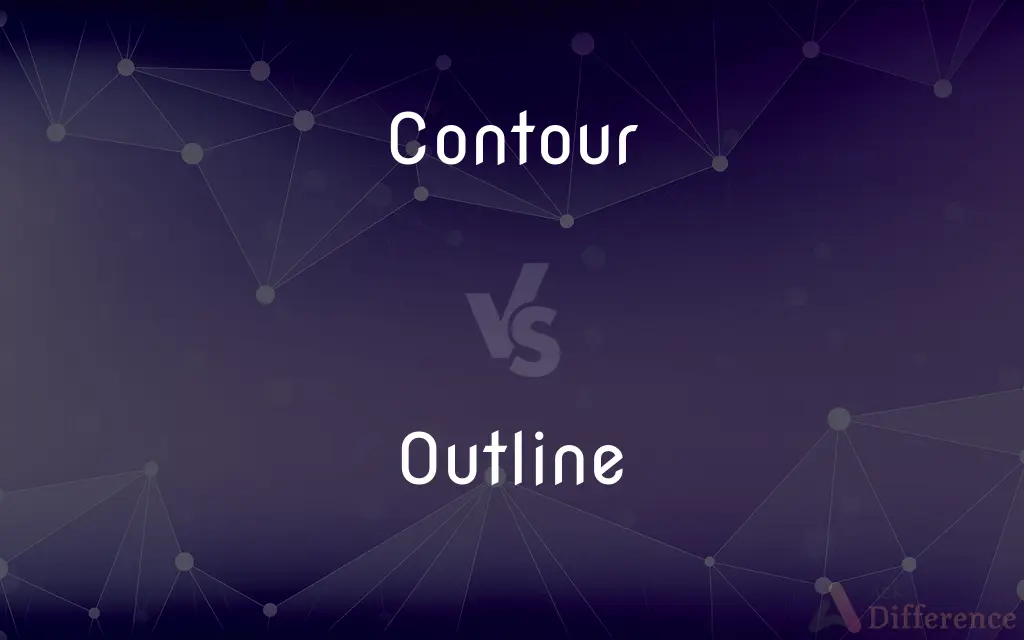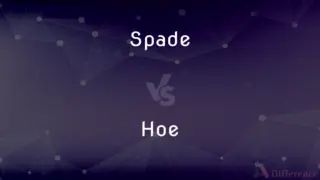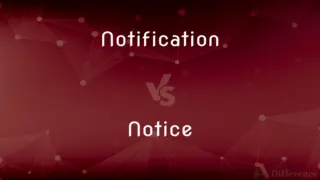Contour vs. Outline — What's the Difference?
Edited by Tayyaba Rehman — By Maham Liaqat — Updated on March 14, 2024
Contour refers to the shape's surface curves, highlighting depth and dimension, while an outline denotes the boundary, emphasizing shape without depth.

Difference Between Contour and Outline
Table of Contents
ADVERTISEMENT
Key Differences
Contours represent the curves and elevations on a surface, suggesting a three-dimensional form through varying lines and shading. On the other hand, outlines define the edge or shape of an object, presenting a two-dimensional perspective without suggesting depth.
Contours are used in maps to indicate terrain and elevation, making the landscape understandable in three dimensions. Whereas, outlines are often used in coloring books, logos, and simple sketches to provide a clear, definable shape to objects without interior detail.
In art, contours can suggest form and volume, giving the viewer a sense of the object's physicality and spatial presence. Whereas outlines are used to define the form's limits, offering a clear distinction between the figure and its background without implying volume.
Contours can vary in thickness and darkness to depict light, shadow, and texture, enhancing the perception of depth. In contrast, outlines typically maintain a uniform thickness and intensity, focusing on defining the boundary.
Contours engage the viewer's perception of space and texture, making them crucial for realistic representations. On the other hand, outlines prioritize clarity and simplicity, making them ideal for abstract or symbolic representations.
ADVERTISEMENT
Comparison Chart
Dimensionality
Suggests three-dimensional form
Indicates two-dimensional shape
Purpose
Depicts depth, elevation, and texture
Defines boundary or shape of an object
Usage
Used in maps, realistic drawings
Used in logos, coloring books, simple sketches
Detail
Can vary in thickness to show texture and depth
Uniform thickness, focuses on boundary
Representation
Implies volume and spatial presence
Emphasizes clarity and simplicity
Compare with Definitions
Contour
A line representing the shape and elevation of land.
The contour lines on the map showed the mountain's steep sides.
Outline
Trace the shape of
Contour
The outline of a figure or body; the edge of a shape.
The artist captured the model's contours with precision.
Outline
The main shape or edge of something, without detail.
From a distance, the mountains were just dark outlines against the sky.
Contour
The surface feature of a thing; the line determining form.
The sculptor examined the contour of the clay figure.
Outline
The boundary or shape of an object.
The outline of the cake was decorated with icing.
Contour
The boundary of a shape that suggests three-dimensional form.
The designer focused on the contour of the new bottle design.
Outline
A line or set of lines enclosing or indicating the shape of an object.
The child drew a rough outline of the house.
Contour
A method in art to suggest volume and depth.
Using contour drawing, she added dimension to the sketch.
Outline
A method of drawing emphasizing clear boundaries.
She preferred using outline techniques for her digital art.
Contour
The outline of a figure, body, or mass.
Outline
A line indicating the outer contours or boundaries of an object or figure
Could see the outlines of an animal in the dark.
Contour
A line that represents such an outline.
Outline
A style of drawing in which objects are delineated in contours without shading.
Contour
A contour line.
Outline
A sketch done in this style.
Contour
A varying characteristic or quality of something, such as a melody.
Outline
A summary of a text or subject, usually presented in headings and subheadings.
Contour
(Linguistics) The distinctive rising and falling patterns of pitch, tone, or stress.
Outline
A preliminary draft or plan, as of a project or proposal.
Contour
To make or shape the outline of; represent in contour.
Outline
To draw or trace an outline of.
Contour
To build (a road, for example) to follow the contour of the land.
Outline
To display or accentuate the outline of
His face was outlined on the lampshade.
Contour
Following the contour lines of uneven terrain to limit erosion of topsoil
Contour plowing.
Outline
To give the main features or various aspects of; summarize
Outlined the major provisions of the tax bill.
Contour
Shaped to fit the outline or form of something
A contour sheet.
Outline
A line marking the boundary of an object figure.
Contour
An outline, boundary or border, usually of curved shape.
The low drag contour of a modern automobile
Outline
The outer shape of an object or figure.
Contour
A line on a map or chart delineating those points which have the same altitude or other plotted quantity: a contour line or isopleth. Category:en:Curves
Outline
A sketch or drawing in which objects are delineated in contours without shading.
Contour
(linguistics) a speech sound which behaves as a single segment, but which makes an internal transition from one quality, place, or manner to another.
Outline
A general description of some subject.
Contour
(figurative) A general description giving the most important points.
Outline
A statement summarizing the important points of a text.
Contour
(transitive) To form a more or less curved boundary or border upon.
Outline
A preliminary plan for a project.
The outline of a speech
Contour
(transitive) To mark with contour lines.
Outline
(film) A prose telling of a story intended to be turned into a screenplay; generally longer and more detailed than a treatment.
Contour
(intransitive) To practise the makeup technique of contouring.
Outline
(fishing) A setline or trotline.
Contour
The outline of a figure or body, or the line or lines representing such an outline; the line that bounds; periphery.
Titian's coloring and contours.
Outline
(transitive) To draw an outline of.
Contour
The outline of a horizontal section of the ground, or of works of fortification.
Outline
(transitive) To summarize.
Wikipedia items featuring books usually outline them after giving their background.
Contour
A line drawn on a map connecting points of equal height
Outline
To optimize for size by replacing repeated code fragments with function calls.
Contour
Any spatial attributes (especially as defined by outline);
He could barely make out their shapes through the smoke
Outline
The line which marks the outer limits of an object or figure; the exterior line or edge; contour.
Painters, by their outlines, colors, lights, and shadows, represent the same in their pictures.
Contour
A feature (or the order or arrangement of features) of anything having a complex structure;
The contours of the melody
It defines a major contour of this administration
Outline
Fig.: A sketch of any scheme; a preliminary or general indication of a plan, system, discourse, course of thought, etc.; as, the outline of a speech.
But that larger grief . . .Is given in outline and no more.
Contour
Form the contours of
Outline
To draw the outline of.
Outline
Fig.: To sketch out or indicate as by an outline; to create a general framework of (a plan, system, discourse, course of thought), for which the details need to be added; as, to outline an argument or a campaign.
Outline
The line that appears to bound an object
Outline
A sketchy summary of the main points of an argument or theory
Outline
A schematic or preliminary plan
Outline
Describe roughly or briefly or give the main points or summary of;
Sketch the outline of the book
Outline his ideas
Outline
Draw up an outline or sketch for something;
Draft a speech
Common Curiosities
How do contours differ from outlines in art?
Contours suggest three-dimensional form and depth, while outlines focus on defining the shape's boundary in two dimensions.
Can outlines and contours be used together?
Yes, outlines can define the overall shape, and contours can add depth and detail within that shape.
What is the main purpose of an outline in design?
The main purpose is to clearly define the shape of an object, making it recognizable without detail.
How do contours enhance the perception of depth?
By varying in thickness and intensity, contours mimic how light and shadow fall on an object, suggesting volume.
In what contexts are outlines preferred over contours?
Outlines are preferred in logos, coloring books, and when a clear, simple representation is needed.
What tools are used to create contours and outlines?
Pencils, pens, digital tools, and even physical materials like clay can be used to create both contours and outlines.
What is a contour?
A contour is a line or series of lines that connect points of equal elevation on a surface, representing the shape and volume of landforms or objects.
How can the use of outlines simplify an image?
By eliminating interior detail and focusing on the boundary, outlines simplify the image to its basic form.
What is an outline?
An outline is a line or set of lines that define the outer edges of an object or figure, emphasizing its shape without interior detail.
Why are contours important in maps?
Contours provide information about terrain and elevation, making it possible to understand the landscape's physical features.
What is the significance of outline in early childhood art?
Outlines help children understand and establish the basic shapes of objects, serving as a foundation for more detailed art.
What is contour drawing in art?
It is a technique that uses continuous lines to capture the edges and surface ridges of objects, suggesting depth.
Do contours have to be accurate in artistic representations?
While accuracy can enhance realism, artistic interpretation often allows for creative variations in contour representation.
Can outlines convey emotion or style?
Yes, the thickness, smoothness, or jaggedness of outlines can convey different emotions or artistic styles.
How do contours relate to three-dimensional modeling?
In 3D modeling, contours can help define the shape and surface features of the model, similar to their use in two-dimensional art.
Share Your Discovery

Previous Comparison
Spade vs. Hoe
Next Comparison
Notification vs. NoticeAuthor Spotlight
Written by
Maham LiaqatEdited by
Tayyaba RehmanTayyaba Rehman is a distinguished writer, currently serving as a primary contributor to askdifference.com. As a researcher in semantics and etymology, Tayyaba's passion for the complexity of languages and their distinctions has found a perfect home on the platform. Tayyaba delves into the intricacies of language, distinguishing between commonly confused words and phrases, thereby providing clarity for readers worldwide.














































